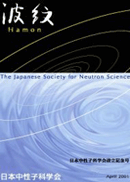20 巻, 1 号
選択された号の論文の21件中1~21を表示しています
- |<
- <
- 1
- >
- >|
-
2010 年20 巻1 号 p. 2-3
発行日: 2010年
公開日: 2018/11/16
PDF形式でダウンロード (950K)
特集記事
-
2010 年20 巻1 号 p. 4-7
発行日: 2010年
公開日: 2018/11/16
PDF形式でダウンロード (4073K) -
2010 年20 巻1 号 p. 8-12
発行日: 2010年
公開日: 2018/11/16
PDF形式でダウンロード (1580K) -
2010 年20 巻1 号 p. 13-15
発行日: 2010年
公開日: 2018/11/16
PDF形式でダウンロード (1115K) -
2010 年20 巻1 号 p. 16-20
発行日: 2010年
公開日: 2018/11/16
PDF形式でダウンロード (2464K) -
2010 年20 巻1 号 p. 21-24
発行日: 2010年
公開日: 2018/11/16
PDF形式でダウンロード (13208K) -
2010 年20 巻1 号 p. 25-29
発行日: 2010年
公開日: 2018/11/16
PDF形式でダウンロード (3241K) -
2010 年20 巻1 号 p. 30-33
発行日: 2010年
公開日: 2018/11/16
PDF形式でダウンロード (1775K) -
2010 年20 巻1 号 p. 34-38
発行日: 2010年
公開日: 2018/11/16
PDF形式でダウンロード (3045K) -
2010 年20 巻1 号 p. 39-44
発行日: 2010年
公開日: 2018/11/16
PDF形式でダウンロード (1641K) -
2010 年20 巻1 号 p. 45-48
発行日: 2010年
公開日: 2018/11/16
PDF形式でダウンロード (1614K) -
2010 年20 巻1 号 p. 49-53
発行日: 2010年
公開日: 2018/11/16
PDF形式でダウンロード (2377K) -
2010 年20 巻1 号 p. 54-57
発行日: 2010年
公開日: 2018/11/16
PDF形式でダウンロード (1285K) -
2010 年20 巻1 号 p. 58-61
発行日: 2010年
公開日: 2018/11/16
PDF形式でダウンロード (1849K) -
2010 年20 巻1 号 p. 62-65
発行日: 2010年
公開日: 2018/11/16
PDF形式でダウンロード (2764K) -
2010 年20 巻1 号 p. 66-69
発行日: 2010年
公開日: 2018/11/16
PDF形式でダウンロード (1969K) -
2010 年20 巻1 号 p. 70-72
発行日: 2010年
公開日: 2018/11/16
PDF形式でダウンロード (2746K) -
2010 年20 巻1 号 p. 73-75
発行日: 2010年
公開日: 2018/11/16
PDF形式でダウンロード (2123K)
入門講座「残留応力」
-
2010 年20 巻1 号 p. 76-79
発行日: 2010年
公開日: 2018/11/16
PDF形式でダウンロード (1350K)
入門講座「中性子スピンエコー」
-
2010 年20 巻1 号 p. 80-83
発行日: 2010年
公開日: 2018/11/16
PDF形式でダウンロード (1490K)
入門講座「中性子検出器」
-
2010 年20 巻1 号 p. 84-88
発行日: 2010年
公開日: 2018/11/16
PDF形式でダウンロード (1173K)
- |<
- <
- 1
- >
- >|
